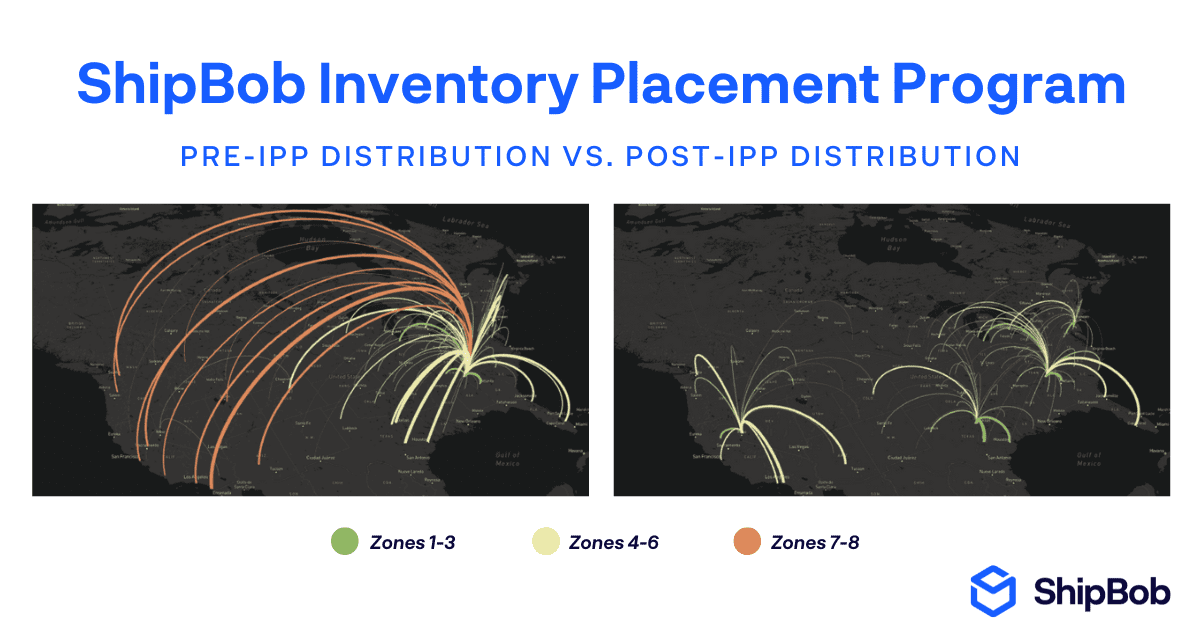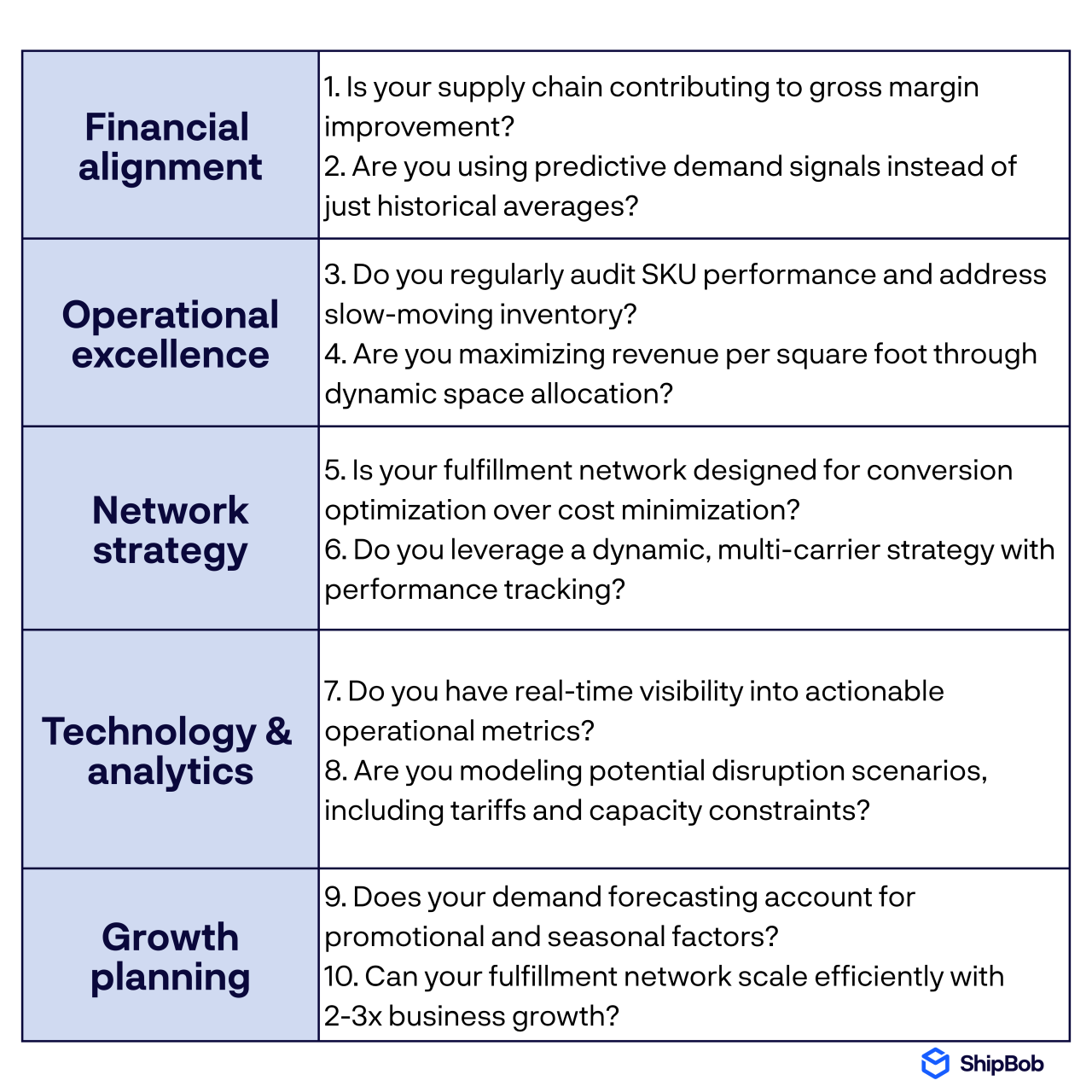Verified & Reviewed
Last updated on October 1, 2025 Written By Melissa Nick

Last updated on October 1, 2025 Written By Melissa Nick
Subscribe for More
In today’s hyper-competitive ecommerce environment, fulfillment strategy has evolved from a back-office necessity to a competitive weapon.
At PARCEL 25, ShipBob’s Chief Supply Chain Officer, Melissa Nick, and SVP of Central Operations, James Solier, shared the playbook that separates industry leaders from everyone else.
Read on to learn how brands engineer their entire supply chain operations to drive revenue, boost conversion rates, and create lasting competitive advantages.
Why inventory optimization is your secret growth weapon
Inventory optimization isn’t just about having products in stock. It’s about strategically positioning your inventory to maximize every aspect of your business performance.
When we analyze the ShipBob merchant network, the results are clear. Brands with optimized inventory strategies see:
- Faster delivery speeds through smart inventory positioning
- Lower shipping costs via improved zone skipping and regional distribution
- Higher conversion rates from accurate delivery promises
- Better gross margins through reduced carrying costs
Inventory strategies that move the needle

Basket analysis
Basket analysis leverages order data to identify which products are frequently bought together, then co-locates them in your fulfillment centers. This simple yet powerful strategy can reduce split shipments by up to 35% while simultaneously increasing average order value.
By strategically placing complementary items near each other (i.e., phone cases next to phone chargers or yoga mats next to resistance bands) pickers can efficiently consolidate multi-item orders into single shipments, reducing both shipping costs and your carbon footprint while improving the customer experience.
SKU velocity segmentation
SKU velocity segmentation ensures fast-moving items are positioned in your “golden zones” for quick access, improving pick efficiency by 40% compared to random slotting. This warehouse optimization technique categorizes inventory based on turnover rates, placing high-velocity SKUs in easily accessible locations closest to packing stations.
Slower-moving items can be stored in less accessible areas, maximizing warehouse space utilization while ensuring your most popular products are always within arm’s reach for faster order processing and same-day fulfillment capabilities.
Regional demand forecasting
Regional demand forecasting uses historical data and demographic insights to predict where demand will spike, enabling proactive inventory positioning that can reduce 2-day delivery costs by 25-30%. This allows you to distribute inventory across multiple fulfillment centers based on anticipated regional demand patterns, seasonal trends, and local market characteristics.
By positioning stock closer to your end customers, you can reduce shipping zones, minimize last-mile delivery expenses, and meet customer expectations for lightning-fast shipping without premium carrier costs.
Here’s the bottom line: you can spend thousands on customer acquisition, but if inventory mistakes create delivery delays, you’re throwing money away.
Free Resource
Partner with a Fulfillment Accelerator
Learn how modern brands are leveraging this new kind of fulfillment solution to transform their supply chain.
How 3PLs become true growth partners, not just vendors
Most third-party logistics providers focus on the basics: pick accuracy, shipping speed, and maybe cost savings. But strategic fulfillment partners like ShipBob align with your growth objectives and bring capabilities that actually move your business forward.
What to look for in a strategic fulfillment partner
Forward-thinking fulfillment partners have specialized capabilities such as:
- Omnichannel fulfillment, supporting D2C, retail, marketplace, and B2B from unified pools of inventory
- End-to-end ownership to ensure support all the way from dock to stock to the customer’s doorstep.
- FDA-registered facilities for food, beverage, health, and beauty products
- Temperature-controlled environments for quality control
- Foreign Trade Zone (FTZ) operations for duty optimization
How to know if you’re working with a strategic fulfillment partner
Multi-year capacity planning aligned with your growth projections
The ability to plan long-term demonstrates a fulfillment partner’s commitment to scaling alongside your business rather than simply processing today’s orders. A strategic partner proactively models your storage and throughput needs based on your growth to ensure you’ll never face capacity constraints. This approach provides the infrastructure foundation needed to support ambitious revenue targets without operational bottlenecks.
Data integration that supports advanced analytics and forecasting
Data integration that supports advanced analytics and forecasting transforms your fulfillment operations into a strategic intelligence center. True fulfillment partners provide seamless API connections and robust reporting dashboards with real-time inventory, order, and shipping data.
These integrations enable sophisticated demand forecasting, inventory optimization models, and predictive analytics that inform your operations and turn your logistics data into a competitive advantage.
If your fulfillment provider isn’t helping you make strategic decisions about inventory and network design, they are likely just a vendor, not a fulfillment accelerator.
Engineering fulfillment networks that drive conversions
Here’s where most brands get it wrong: they choose their fulfillment network based on cost minimization instead of conversion optimization. The smartest brands flip this approach entirely.
Start with conversion goals
Use customer density data and order velocity patterns to choose fulfillment centers where they’ll have maximum impact on delivery promises and customer satisfaction. ShipBob completes these analyses on behalf of its merchants.
Product-specific strategy
Different products need different approaches.
Consider the following:
- High-velocity, low-weight items, such as supplements, beauty products, and apparel, may need centralized fulfillment with expedited shipping options.
- Bulky, heavy products, such as furniture and appliances, are best suited for regional distribution to minimize shipping costs.
- Temperature-sensitive goods, such as food and beverage products, need specialized facilities with proper handling procedures.
- Hazmat items, such as beauty products with aerosol, hand sanitizers, and other chemical-based products, require certified facilities with compliance protocols.




Semaine Health offers 1-day delivery to nearly 70% of customers
When Semaine Health expanded from one to four strategically positioned fulfillment centers with ShipBob, the transformation was dramatic:
- 67% of customers gained access to 1-day delivery
- Cart abandonment decreased by 22% due to better delivery promises
- Customer lifetime value increased by 19% from improved satisfaction
- Total fulfillment costs dropped 15% despite network expansion

This was the result of ZIP code-level demand analysis, seasonal adjustments, and strategic carrier mapping for each facility’s coverage area through their partnership with ShipBob.
“Since launching ShipBob’s Inventory Placement Program, we’ve been able to allocate our inventory across 4 of ShipBob’s fulfillment centers in the United States, which cut our shipping times by a third – from 5.2 days down to about 3.6 days. Not only has transit time dropped, but at the same time we reduced fulfillment costs by over $2 per order compared with our old 3PL. This combination has been key to profitable growth this year.”
Matt Crane, Co-Founder and Chief Science Officer at Semaine Health
Shipping strategy: Experience beats carrier logos every time
Your customers don’t care whether you use FedEx, UPS, or regional carriers. They care about getting their orders fast, affordably, and reliably. This shift in thinking unlocks massive opportunities for cost savings and service improvements.
Advanced shipping tactics
Dynamic carrier selection
Dynamic carrier selection uses real-time algorithms to choose carriers based on multiple performance and cost factors, ensuring every package ships via the optimal route.
Rather than defaulting to a single carrier partnership, sophisticated fulfillment operations evaluate:
- Service level commitments and reliability history
- Cost optimization across all shipping zones
- Capacity availability during peak periods
- Performance metrics and customer satisfaction scores
Regional carrier integration
Don’t sleep on regional carriers. While national carriers like UPS and FedEx offer broad coverage, regional players like OnTrac, LSO, or regional USPS optimization can deliver packages faster and cheaper in specific areas of the US (i.e., the West Coast, Northeast, etc.).
Leveraging specialized carriers can offer superior service at lower costs, significantly improving your customer lifetime value through faster deliveries and reduced expenses. They also provide backup capacity during peak seasons, ensuring your customers receive consistent delivery experiences year-round.
Predictive delivery analytics
Use machine learning to provide accurate delivery estimates that account for carrier performance history, weather patterns, facility processing times, and peak season constraints.
By setting realistic expectations upfront and proactively communicating delays before customers notice them, you build trust and turn the delivery experience into a brand differentiator.
Technology infrastructure for future-ready operations
Future-proof fulfillment requires technology that can adapt as your business grows and market conditions change. Here’s what actually matters:
Core technology requirements
Order Management Systems (OMS)
OMS provide real-time inventory visibility across all channels, intelligent order routing, and automated exception handling to keep orders flowing smoothly. The OMS orchestrates inventory allocation across multiple warehouses, sales channels, and fulfillment methods while preventing oversells and stockouts.
Warehouse Management System (WMS)
A WMS can offer AI-powered slotting optimization, labor management tools, and quality control automation that maintains 99.5%+ inventory accuracy across your fulfillment network. Going beyond the traditional barcode scanning, a modern WMS can optimize picking workflows, act as a checks-and-balances system against mispicks, and track productivity metrics to transform your warehouse operations.
Unified analytics
Unlock comprehensive insights into SKU profitability, SLA performance tracking, demand forecasting, and network optimization recommendations with advanced, unified analytics. Rather than juggling data from multiple systems, this approach consolidates fulfillment metrics into an actionable dashboard so you can access holistic, real-time data that can enable informed business decisions.
Integration capabilities
Your systems need to work well together. Look for API-first architecture that seamlessly connects with your ecommerce platform, marketplace channels, ERP systems, and marketing tools.
Order data should flow automatically from your ecommerce platform to your fulfillment provider or WMS, sync inventory updates instantly across channels, and trigger shipping confirmation emails without manual data exports or custom coding projects.
10 questions to pressure-test your fulfillment strategy
Use this framework to evaluate where you stand with your current fulfillment strategy:

Your action plan for fulfillment excellence
Use these tips to enhance your fulfillment strategy over the course of the next year.
Quick wins
In the first thirty days, consider these steps:
- Audit your current inventory positioning for optimization opportunities
- Implement carrier performance tracking and diversify shipping options
- Start monitoring conversion rates tied to delivery performance
Strategic moves
In the next 3 months, consider these steps:
- Deploy advanced demand forecasting with regional granularity
- Optimize fulfillment network design based on customer distribution
- Implement proactive customer communication for delivery exceptions
Long-term investments
In the next 6 months to a year, consider these steps:
- Build omnichannel capabilities supporting multiple sales channels
- Develop predictive analytics for continuous optimization
- Create scalable architecture supporting 3-5 year growth plans

Ready to transform your fulfillment operations?
ShipBob’s global network of strategically positioned fulfillment centers and advanced technology platform has helped thousands of brands transform their operations into competitive advantages.
Connect with ShipBob’s order fulfillment and supply chain experts to turn fulfillment into your competitive advantage.





